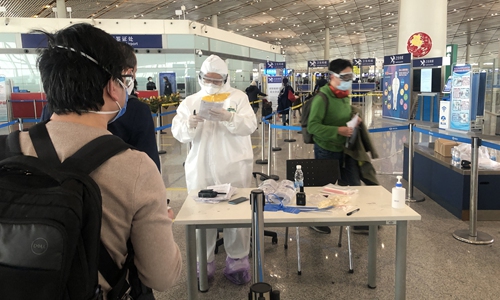New COVID-19 transmission model shows social distancing worked in Chinese cities
Source:Xinhua Published: 2020/5/1 7:16:22

International passengers line up at a distance of 1 meter between each other when handing in the health declaration cards at the Beijing Capital International Airport. Photo: Liu Xin/GT
A new COVID-19 transmission model, based on contact survey data from nearly 1,200 people in the Chinese cities of Wuhan and Shanghai, suggests that strict social distancing measures were sufficient to curtail the transmission of SARS-CoV-2, the virus causes COVID-19, according to a paper published on Science magazine Wednesday.
The results show that the average resident's daily interpersonal contacts dropped 7 to 9 fold, from 14 and 20 people per day in Wuhan and Shanghai, respectively, to about two contacts per day in both locations by early February, after social distancing measures were put in place.
The survey data suggests that between 78 and 94 percent of these contacts occurred at home and between fellow household members, during the social distancing period.
The research team led by Juanjuan Zhang of Fudan University used the contact survey data, along with contact tracing data collected in the nearby province of Hunan, to build a mathematical model of SARS-CoV-2 transmission dynamics.
Their model results suggest that social distancing measures, and the resulting decrease in daily interpersonal contacts, led transmission rates to drop below epidemic levels in Wuhan and Shanghai, according to the study.
The study also found that children under 15 years old are 40 percent as susceptible to SARS-CoV-2 infection as elderly people over 64 years old.
While proactive school closures cannot interrupt transmission on their own, they can reduce peak incidence by 40 to 60 percent and delay the epidemic, according to the study.
Posted in: SOCIETY